Beckhoff FC510x
The FC510x is a CANopen master card with one (FC5101) or two (FC5102) channels. It supports all CANopen Communication Modes and complies with the CANopen specification DS301V4.01. The card can synchronize the related PLC or NC task using CANopen SYNC. It is a good idea to control drives via the bus in "master" synchronization mode as the SYNC objects are averagely transmitted with quartz precision and the process data exchange is synchronized throughout with the application.
The CANopen master card provides numerous diagnosis possibilities. Emergency objects are stored and can be read via ADS.
The two-channel card FC5102 has two independent microprocessor systems. Therefore, the two channels do not interfere with each other. The CAN interfaces are galvanically isolated (-> hardware description).
Context menu

Append Box... <Insert>
Adds CANopen slaves (boxes). For an Overview of all currently supported CANopen devices, please see...
Delete Device... <Del>
Removes the FC510x fieldbus card and all subsidiary elements from the I/O configuration.
Online Reset
Initiates an online reset on the CANopen bus.
"FC510x" tab
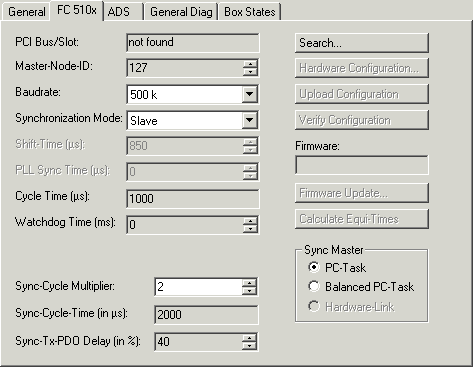
PCI Slot/Irq:
Shows in which logical PCI slot the card was detected and which IRQ is assigned to it. The IRQ is unused.
Master Node Id:
Node address for the FC510x. Value range: 1...127. Determines the identifier of the master heartbeat telegram. Ensure that it is not the same as a slave node address.
Baud rate:
Set the Baud rate here. Automatically tests whether the connected slave also supports this baud rate.
Synchronization Mode:
The synchronization mode determines the accuracy of the CANopen SYNC telegram generation.
The highest priority task linked with the FC510x device controls the CANopen card and is thereby synchronized with the fieldbus. All other tasks are served asynchronously via corresponding buffers. For all operating modes you can individually set the communication type for each process data object (PDO) - event driven or synchronized (in each PDO tab). If one of the PDOs has been configured for synchronous operating mode, a SYNC telegram is sent at the start of the cycle, which the slaves use to synchronize their actions with the master cycle.
Depending on the sync accuracy requirements of the application several modes can be selected. Please note, that due to CAN technology a single SYNC telegram may jitter for one entire frame length it the bus is busy at the time of sync generation. The SYNC accuracy therefore refers to the long-time stability. Bus nodes that use a phase locked loop (PLL) mechanism to synchronize themselves require a maximum long-time stability or accuracy of the SYNC.

Slave
In slave synchronization mode the card receives its time basis from a sync master. The sync master is selected at the corresponding field.
- Sync Master: PC-Task. This is the default setting. The PC provides the time basis using the TwinCAT Real Time. Depending on the settings the Task start (Default with TwinCAT NC) or the Task end (Default at TwinCAT PLC) triggers the SYNC telegram.
- Sync Master: Balanced PC Task. This operating mode as well generated the CANopen Sync cycle with the long term accuracy of the PC time basis. However, the short term accuracy (interval between two SYNC telegrams) is better that with Sync Master "PC-Task":
- Run time differences (e.g. caused by case dependent program calls) are leveled out,
- the FC510x delays pending transmit telegrams until the SYNC telegram was sent,
- the SYNC intervals are determined by the quartz timer of the FC510x card.
- The card timer is adjusted in small steps to the PC-timer if the difference is larger that the value of the "PLL Sync Time".
- In this mode the SYNC telegram is delayed for the Shift Time after the end of the TwinCAT task cycle. Here the shift time should be set to a value as small as possible
- but large enough to allow the process data access by the TwinCAT task. The function "Calculate Equi-Times" helps to configure the optimal shift time. It is started by selecting the corresponding button.
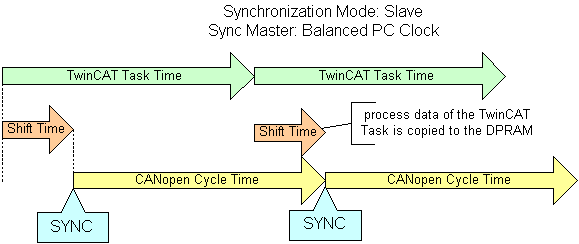
Master
In master synchronization mode the card generates its time basis locally. The SYNC is generated with long time quartz accuracy. The start of the TwinCAT task is triggered by the card, delayed by the Shift Time. In this mode the shift time value should be as large as possible. The function "Calculate Equi-Times" helps to configure the optimal shift time. It is started by selecting the corresponding button.

Cycle Time:
Displays the cycle time of the corresponding highest priority task. The value is updated when the TwinCAT mapping is generated.
Sync-Cycle Multiplier:
CANopen SYNC Cycle Time = (Task) Cycle Time x Sync-Cycle Multiplier. Event driven PDO communications and cyclic synchronized PDO communication are frequently combined when used in conjunction with CANopen. To be able to respond rapidly to an event, the TwinCAT task cycle time has to be less than the CANopen SYNC cycle time.
Sync-Cycle time
Shows the cycle time of the CANopen SYNC telegram. This cycle time is derived from the highest priority task which has process data linked to the card, and the Sync Cycle Multiplier.
Sync-Tx-PDO Delay:
Directly after the SYNC telegram, the synchronized slaves send their input data/actual values. The FC510x can delay the sending of the output data / set value (TxPDOs from the perspective of the card) to minimize the telegram, burst directly after the SYNC. The Sync-Tx-PDO delay parameter is used to set this delay in percent of the Sync Cycle Time.
Example:
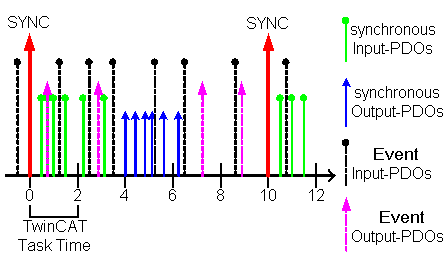
Task Cycle Time = 2000µs, Sync Cycle Multiplier = 5, Sync Tx-PDO Delay =40[%]. Event driven PDOs can be processed by the PLC task every 2 ms. The CANopen sync cycle is 10 ms, the FC510x sends its synchronized PDOs 4ms (=40% of 10ms) after SYNC.
Search...:
Searches for all connected FC510x channels. Select those required. In the case of an FC5102 both channels A and B appear. These behave in logical terms like two FC5101 cards.
Hardware Configuration …:
In which the address of the FC510x is set in the lower memory area (below 1 MB) of the PC.
Upload Configuration:
Scans the CANopen network and adds all detected equipment to the device (FC510x) (only available when no box has been configured). In the case of Beckhoff boxes, reads the configuration precisely. In the case of external devices, the PDO configuration and the identity object are read and evaluated.
Verify Configuration:
Allows one to compare the expected (configured) network configuration with the actual (physically present) configuration. The data from the CANopen Identity object is read an compared. In the case of Beckhoff Boxes the connected Bus Terminals or Extension Modules are identified ad compared. In preparation.
Firmware:
Shows the current firmware version of the FC510x.
Firmware update...:
The FC510x card firmware version is updated here.
 | Stop TwinCAT The TwinCAT system must be stopped for this function. |
”ADS” tab
The FC510x is an ADS device with its own net ID, which can be changed here. All ADS services (diagnosis, non-cyclical communication) going to the FC510x must address this net ID.
”Box States” tab
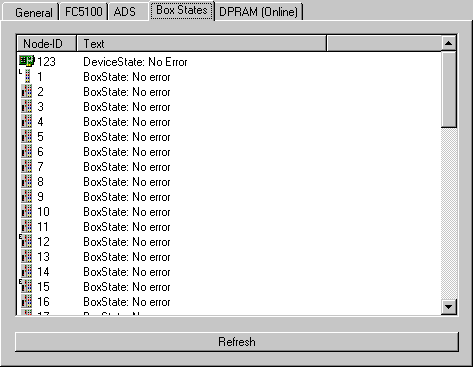
Displays an overview of all current box statuses.
Diagnostic inputs
The FC510x automatically provides various diagnostic variables which describe the status of the card and the CANopen network:
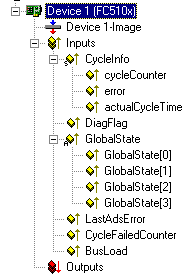
cycleCounter: Is incremented at the end of each firmware cycle so that this variable can indicate whether the last cycle was completed before the task was started.
error: Shows the number of slaves whose BoxState is not equal to zero. The BoxState of the slaves must only be checked if this value is not 0.
actualCycleTime: Shows the actual cycle time in 4/25 µs. This variable is only updated when all slaves are involved in the data exchange (and when error is 0).
DiagFlag: Shows whether the diagnostics information on the card has changed. This can be read off using ADS-Read. To this end, specify the net ID of the FC510x, the port number 200, and the IndexGroup 0xF100. The IndexOffset and the length are then based on the diagnostic data. The BoxStates are also directly available as box variables.
Offset 1–127: BusStatus List, one byte for each station address from 1–127 which contains the station status (see BoxState for CANopen boxes)
Global State: Various diagnostic and status displays for the FC510x. The byte in GlobalState(0) indicates the status of the card in relation to the TwinCAT system: the potential statuses are RUN, RESET, OFFLINE, and STOP. GlobalState(2) gives information on the state of the CAN controller: "CAN warning limit reached" and "Bus off" are displayed. "Warning limit reached" means that the send/receive error counter on the CAN controller has exceeded the value 96. BusOff means that the CAN controller can no longer participate in bus communication due to too many CAN errors (Error frames). In this case, there is a serious physical error in the CAN network. (e.g. too few or too many termination resistors, at least one device with incorrect baud rate, short circuit, etc.) The "bus off" state can only be exited through a card reset. Details on further global state data, see comments in "Online" tab.
LastAdsError: Shows the error code of the last ADS access error, e.g. if an attempt has been made to read the diagnostic data for a deactivated node.
CycleFailedCounter: Counts the number of firmware cycles which could not be completed before the associated task wanted to re-read/re-write the process image. If this counter is incremented, the task cycle time has been set too low for the actual network configuration.
BusLoad: Shows the current bus load in %. The Bus Load is an important design criterion for CAN networks. The value shown is an average value over 100 ms.